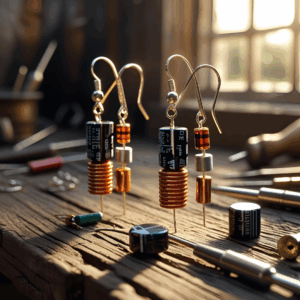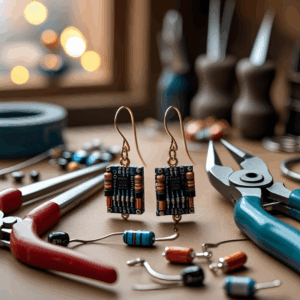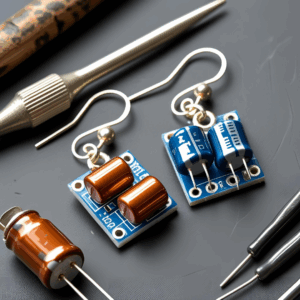In a world overflowing with discarded gadgets, there’s a growing movement of makers and artists transforming outdated electronics into stunning handcrafted pieces. Whether it’s a wall clock made from a retired motherboard or jewelry featuring vintage resistors, this trend doesn’t just reduce e-waste — it reimagines what technology can be.
Welcome to the world of electronic upcycling in modern crafts, where sustainability meets innovation, and your old devices get a second life as functional and decorative art.
What Is Electronic Upcycling?
Electronic upcycling is the process of repurposing components from broken or obsolete devices into new objects that are useful, decorative, or expressive. Unlike recycling, which often breaks down materials into raw elements, upcycling maintains the integrity of components — giving them renewed purpose without significant energy use.
Why Upcycle Electronics in Craft?
- Reduces e-waste and keeps hazardous materials out of landfills
- Encourages creative problem-solving
- Provides free or low-cost materials for DIY projects
- Adds a unique tech-inspired aesthetic to handmade items
- Educates about sustainability and the lifespan of devices
Plus, there’s a certain satisfaction in knowing that your old smartphone’s circuit board is now a sleek belt buckle or a lamp base.
Common Electronic Parts You Can Reuse
Before you toss that broken gadget, take a closer look. Many components are not only reusable, but visually striking and functionally interesting.
Motherboards and Circuit Boards
- Flat, colorful, and full of patterns
- Great for wall art, coasters, clocks, or jewelry backplates
- Can be cut, sanded, and painted
Wires and Cables
- Use as structural elements in sculptures
- Wrap around frames or twist into shapes
- Excellent for basket weaving, plant hangers, or abstract art
Resistors, Capacitors, and LEDs
- Perfect for detailed jewelry (earrings, rings, pendants)
- Great for mosaic-style artwork or tech-themed accessories
- Still usable in low-voltage hobby electronics
Fans, Heat Sinks, and Casings
- Fans become wind-powered kinetic art
- Heat sinks make robust keychains or pen holders
- Casings serve as the base for new lamps, containers, or small storage boxes


Safety First: Handling Electronic Waste for Crafting
Before diving into any project, it’s critical to ensure safe handling of electronics. Some components may contain sharp edges or toxic substances.
Safety Tips
- Always wear gloves when disassembling devices
- Avoid components that contain lithium batteries or CRT tubes
- Use ventilated areas if cutting or sanding parts
- Clean all components with alcohol or mild soap before crafting
- Use protective eyewear when drilling or soldering
Your health is just as important as the planet’s.
Tools and Materials for Electronic Upcycling
A few tools can take your upcycled crafts to the next level. You don’t need a high-end workshop — just basic supplies and creativity.
Useful Tools
- Small screwdrivers and pliers for disassembly
- Hot glue gun or epoxy for mounting components
- Dremel tool for cutting plastic or circuit boards
- Fine sandpaper for smoothing sharp edges
- Soldering iron for reusing LEDs or assembling mini circuits
- Jewelry tools for wire shaping and bead setting
Complementary Materials
Pair tech with organic or traditional craft materials for visual contrast:
- Wood: Use as a base or frame for circuit board art
- Resin: Encapsulate small parts into keychains or pendants
- Yarn or fiber: Wrap cables into soft sculptures
- Clay or concrete: Build housings that incorporate tech details

Creative DIY Ideas Using Electronic Waste
Ready to transform trash into treasure? Here are inspiring and practical projects that mix art, design, and sustainability.
Circuit Board Wall Art
Turn old PCBs into a modern, tech-inspired mosaic.
Steps:
- Cut boards into geometric or abstract shapes
- Mount on a wooden panel or canvas
- Add labels, lights, or resin finishes
- Frame it for a sleek, gallery-ready piece
This project works well in offices, maker spaces, or tech-themed rooms.
Tech Jewelry
Make wearable art with tiny parts that used to power your devices.
Examples:
- Capacitor earrings with wire-wrapped detailing
- Resistor bracelets strung like colorful beads
- Motherboard pendant encased in resin
Add earring hooks or chain links to finish. You can even include QR codes or tiny NFC chips for interactive functionality.
Cable Sculptures
Tangle doesn’t have to mean trash. Use USB cables and wires to sculpt.
Ideas:
- Wire bonsai trees
- Abstract animals
- Geometric wall hangings
- Cable-wrapped photo frames
This is an ideal project for older kids and adults alike, offering both tactile fun and design potential.
Upcycled Gadget Lamps
Transform old devices into functional lighting.
Materials:
- A broken speaker casing, CPU tower, or retro phone
- LED strips or low-wattage bulbs
- Switches or touch sensors salvaged from electronics
Add mood lighting to your desk with tech that once did something completely different.
Decor With Meaning
Use pieces of electronics to craft items that tell a story — perhaps a shadow box using parts from your first laptop, or a clock shaped from a game controller shell. These personalized pieces add character to your space while preserving memories.
Tips to Maximize Sustainability in Your Projects
While upcycling is inherently sustainable, you can amplify your impact with smart choices.
Source Responsibly
- Collect from your own e-waste, friends, or local electronics recycling centers
- Ask schools or offices if they have devices to discard
- Check online marketplaces for broken electronics sold for parts
Design for Disassembly
Make your crafts modular or rebuildable. Avoid permanent gluing when you can screw or snap things in place — making future upgrades or recycling easier.
Combine with Recycled and Natural Materials
Mix tech with:
- Driftwood
- Recycled paper
- Organic fabrics
- Clay and ceramics
This not only improves the visual balance but also reduces your project’s carbon footprint.
Educate While You Create
Share your projects online or at local maker fairs. Help others understand the beauty of reuse and the potential of discarded electronics. Include:
- Before and after photos
- Build guides
- Environmental impact facts
Inspiring others multiplies the effect of your work.
Why Modern Crafts Need Electronic Upcycling
Modern crafting is no longer just about aesthetics. It’s about storytelling, responsibility, and innovation. By incorporating electronics into your creations:
- You elevate DIY to something educational and impactful
- You connect the past and future of technology
- You highlight waste reduction in a visual and tactile way
Crafting with upcycled tech transforms the narrative around electronics — from short-lived to endlessly reimagined.
Where to Sell or Share Your Upcycled Creations
Many people appreciate the blend of tech and handmade charm. These platforms welcome sustainable electronic crafts:
- Etsy – for jewelry, wall decor, or functional art
- Instagram/Pinterest – for visual storytelling and tutorials
- Local eco-markets or maker fairs
- Upcycling blogs and YouTube – share your process to inspire others
- Art galleries and exhibitions – especially those focused on sustainability or tech themes
You can also use your work to apply for environmental design grants or educational residencies.
The Future of Tech Is in Your Hands
E-waste is one of the fastest-growing waste streams in the world. But with creativity, awareness, and a bit of effort, we can reverse that trend — one DIY project at a time.
Upcycled electronic crafts aren’t just objects. They’re messages. They say: “I care about the planet.” They say: “I see value where others see garbage.” Most importantly, they say: “The future of design is circular, not disposable.”
So pick up that broken phone or tangled cord. Your next masterpiece is already in your junk drawer.







